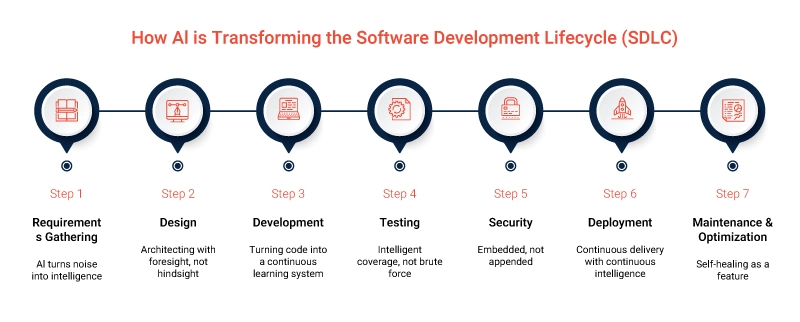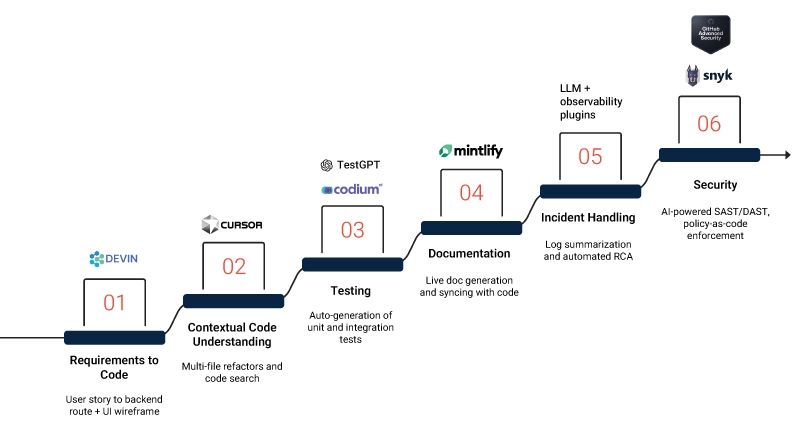October 13, 2025 - by Gitesh Tripathi
Artificial Intelligence (AI) has become one of the most overused buzzwords in technology. Yet, beyond the hype, AI in software development is quietly reshaping software development meaningfully. From coding assistance to automated testing and security reviews, AI can unlock real business value when adopted with discipline and vision. However, without governance and strategic alignment, AI adoption in enterprises can magnify risks, create technical debt, and fail to scale beyond pilots.
In this blog, I’ll share a CTO’s perspective on separating hype from reality, where AI in software development drives real value today, and what leadership mandates must guide its enterprise adoption. I will also clarify:
- What AI realistically enables in software development today
- What remains speculative
- How CTOs can lead strategically through the hype
The Leadership Mandate on AI
AI dominates boardroom and product conversations, but the signal-to-noise ratio is low. Value, not hype, is the key to every AI initiative. The underlying question is: How do you innovate and stay ahead of competitors while ensuring AI in software development drives tangible business outcomes?
AI is not just a buzzword but a specialized discipline that creates intrinsic (efficiency, automation) and extrinsic (competitive differentiation, customer experience) value. As CTOs, we must balance innovation with operational rigor and long-term value. Roadmaps must keep security, AI governance in software development, and measurable outcomes at the core of every AI initiative.
Decoding the Hype Cycle
What’s behind the AI buzz in software development? Recent traction around Agentic AI and development agents for the full SDLC raises the question: are they really effective? The answer is yes and no.
Effectiveness depends on context:
- Enterprise-grade, complex applications → AI alone is insufficient.
- Product development with nuanced requirements → requires human-AI collaboration.
- Straightforward, low-complexity applications → AI can deliver significant automation.
Take, for example, Anthropic CEO’s comment that “half of entry-level white-collar jobs may be wiped out in the next 5 years.” Although he made this claim, my perspective as a CTO is more cautious: while AI in software development adds real efficiency, most use cases still require human oversight, creativity, and contextual judgment. Writing sophisticated, business-critical code still depends on human expertise.
Why early pilots often fail
- Organizational readiness gaps (security, data quality, and change management).
- POCs not designed for scale (there is no roadmap for production rollout).
- Misaligned stakeholder expectations (focusing on novelty instead of value).
In application development, leaders must differentiate novelty from capability:
- Novelty → autocomplete, code explanations, and Copilot usage.
- Capability → AI agents for CI/CD integration, automated pull request reviews, and security risk identification.
Without guardrails, organizations risk shadow IT. Teams adopting agents or extensions without architectural/security oversight lead to technical debt, compliance risks, and security vulnerabilities.
To establish AI in software development as a critical pillar of your development strategy:
- Invest strategically, not just in isolated POCs.
- Create guardrails and centralized governance.
- Upskill teams with realistic productivity metrics.
- Remember: humans + AI = velocity and quality. AI is not a substitute for engineering expertise.

Real-world Value Creation: Where AI Is Actually Impactful Today
Let us first understand what type of AI tooling is used, how they differ, and what kind of impact they can make from a generic perspective.
TAI tooling can be segregated under:
- AI Agents, such as Devin, typically behave almost autonomously when performing complex tasks.
- At the heart of AI Assistants are prompts where you ask the LLM model to assume specific roles, such as “Assume you are a Business Analyst,” and then ask it to perform tasks related to those roles. The more you play around with it, the more refined the outcomes you will start getting.
- AI Copilot, extensively used as a pair programmer, well integrated as part of code repo or IDE tooling, for example, GitHub Copilot
The use of some or all of the above tooling in some way or other in SDLC improves overall development efficiency for developers, business analysts, QA engineers, and DevOps engineers.
For developers, AI in software development reduces time wasted on searching for snippets. This helps testers generate use cases that traditionally take time; for business analysts, it generates documents around a specific domain; for DevOps, it generates YAMLs; and so on. Many such cases contribute to improving the overall efficiency of the SDLC lifecycle.
Below is a list of the tools that help create impact in SDLC:

Enterprise Considerations: From Mere Tools to Strategic Enablers
AI adoption at scale demands transparency and accountability. Black-box models pose risks in high-stakes environments (e.g., finance, healthcare, defence). Without explainability, trust and auditability break down.
Leaders must treat AI models as production assets, applying AI governance in software development to ensure:
- Data governance ensures input/output integrity, privacy, and regulatory compliance.
- Security concerns emerge around model poisoning, prompt injection, and API abuse.
One needs to treat models as production assets, with a lifecycle, access controls, and monitoring. AI capabilities can be embedded into internal platforms or sourced via external APIs. Architecture should reflect data sensitivity, use case maturity, and control requirements.
AI can accelerate delivery, but without governance, it can accelerate entropy. Left unchecked, AI in software development may generate redundant, non-idiomatic, or insecure code that bloats systems and increases long-term maintenance costs. AI doesn’t fix bad engineering practices; it scales them. Guardrails, code review, and standards enforcement are non-negotiable.
Whatever tools you choose should be able to measure minimal integration friction, low training and onboarding cost, focus on TCO, security posture, fine-tuning capabilities, and support SLAs. It needs to be thought through, not just features.
Leadership must inculcate the thought process of seeing AI as not an augmentation tool or a replacement for people. The AI-driven engineering future is developer-empowered, not developer-less. Tools like Copilot, Cursor, and Devin act as smart teammates, accelerating development while keeping engineers in control. AI tooling effectiveness depends on people. Upskilling must go beyond Python or ML; it should cover prompt engineering, refining output quality through iteration and critique, and understanding how data quality affects model behaviour.
AI Implementation Use Case
Leveraging Devin for Legacy Code Analysis and Quality Improvement
As part of an ongoing modernization initiative for one of our customers’ legacy applications, we leveraged Devin, an AI-powered software engineering agent, to accelerate the understanding of a legacy application, streamline bug triaging, and highlight areas for code and architectural improvement. The legacy system had limited documentation, resulting in high onboarding time for new developers and an accumulating backlog of issues. Devin’s capabilities enabled us to reduce manual analysis efforts, improve triage accuracy, and prioritize refactoring candidates.
Challenges
- Poor Documentation: The legacy codebase lacked up-to-date architectural and functional documentation, making onboarding and maintenance difficult.
- High Bug Volume: An increasing number of unresolved bugs, many of which were interdependent or miscategorized.
- Code Complexity: Spaghetti code, tight coupling, and inconsistent coding practices hindered maintainability and testing.
- Time Constraints: Manual code review and triage were time-consuming and error-prone, affecting delivery timelines.
Outcomes
| Metrics | Before Devin | After Devin |
|---|---|---|
| Time to analyse the new module | ~8 days | <2 days |
| Bug triage accuracy (QA-verified) | ~40% | >70% |
| Developer onboarding time | 2–3 weeks | <1 week |
Lessons Learned: Strategic Principles for AI Adoption
Start by focusing on constrained, high-friction areas (e.g., test case generation, boilerplate code). Use scoped pilots with measurable outcomes. Quantify impact (e.g., time saved, error rate reduction). Use A/B testing or internal benchmarks before full deployment. Developers need confidence in AI recommendations. Provide transparency (e.g., code diffs, rationale) and allow human override. Operationalize only after early wins. Invest in integration, monitoring, and feedback mechanisms before expansion.
This illustrates how AI in software development can drive measurable business outcomes when scoped and governed properly.
What CTOs Should Be Thinking About Now
As AI moves from experimentation to enterprise integration, the role of the CTO is undergoing a significant transformation. CTOs are not just technology strategists; they are AI translators, governance leaders, and force multipliers of innovation. CTOs must act as AI adoption in enterprises champions, balancing technology, business, and risk. To lead effectively in this next wave of disruption, CTOs should prioritize the following imperatives:
1. Prioritize Technical Hygiene
Before racing toward AI adoption, ensure clean codebases, reliable CI/CD pipelines, and high-quality, trustworthy data. These elements are prerequisites for effective AI integration, reducing downstream technical debt and enabling scalable experimentation.
2. Establish an AI Steering Group
Form a cross-functional AI council that includes engineering, product, legal, and security leadership. This body should guide AI adoption, identify opportunities and risks, and ensure department alignment. AI is not a siloed initiative; it demands enterprise-wide coordination.
3. Implement Responsible AI Practices
Governance is non-negotiable. Develop clear policies for model accountability, retraining thresholds, bias detection, and auditability. Responsible AI isn’t a checklist but a continuous discipline spanning the model lifecycle.
4. Position AI as a Force Multiplier for Talent
AI augments, not replaces, engineering excellence. Smartly embedded, AI tools can elevate developer productivity, accelerate QA cycles, and improve incident response. CTOs should champion AI as a copilot, not a competitor, for technical teams.
5. Bridge the Gap Between Technology, Business, and Risk
In a world increasingly shaped by algorithms, CTOs must serve as interpreters: translating technical possibilities into business outcomes while balancing compliance and risk. This translational leadership is what will set successful CTOs apart.
Conclusion
AI in software development is neither a silver bullet nor a fad. The organizations that will win are those that move deliberately: piloting in high-friction areas, scaling with governance, and embedding AI into the developer experience without sidelining human judgment.
For CTOs, the mandate is clear: focus on business value, enforce AI governance in software development, invest in talent, and position AI as a core enabler of innovation. The hype will fade, but enterprises that scale AI adoption in enterprises responsibly will outpace those that treated it as novelty.
About the Author
Gitesh Tripathi is the Chief Technology Officer at Synoptek. He has over 22 years of experience across diverse domains including FinTech, Telecom, Insurance, Telemedicine, Account Aggregation, and more. At Synoptek, he creates, coaches, and mentors hi-performance technology teams and consults on Platform and Product Engineering, Center of Excellence, and Digital Engineering Services.

